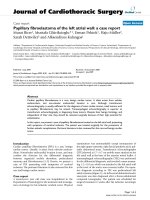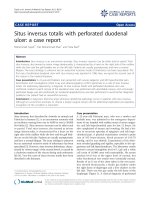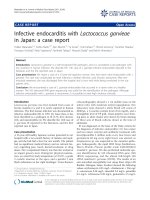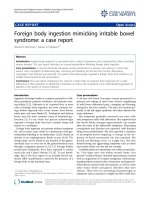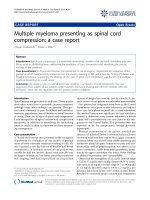Báo cáo y học: " Corneal melting after collagen cross-linking for keratoconus: a case report" docx
Bạn đang xem bản rút gọn của tài liệu. Xem và tải ngay bản đầy đủ của tài liệu tại đây (1.37 MB, 5 trang )
CAS E REP O R T Open Access
Corneal melting after collagen cross-linking for
keratoconus: a case report
Georgios Labiris
1,2*
, Eleni Kaloghianni
1
, Stavrenia Koukoula
1
, Athanassios Zissimopoulos
3
and
Vassilios P Kozobolis
1,2
Abstract
Introduction: Corneal collagen cross-linking is a rather new technique that uses riboflavin and ultraviolet A light
for collagen fiber stabilization in keratoconus corneas. Other than reversible side effects, the preliminary results of
corneal collagen cross-linking studies suggest that it is a rather safe technique. In this rep ort, we demonstrate a
case of corneal melting after corneal collagen cross-linking for keratoconus corneas associated with an acute
inflammatory response.
Case presentation: A 23-year-old Caucasian man with keratoconus cornea stage 1 to 2 underwent uneventful
corneal collagen cross-linking treatment according to the Dresden protocol. The next day the patient had intense
photophobia, watering and redness of the eye, and his visual acuity was limited to counting fingers. Slit lamp
biomicroscopy revealed severe corneal haze accompanied by non-specific endothelial precipitates following an
acute inflammatory response. Mild inflammation could be detected in the anterior chamber. Moreover, the re-
epithelialization process could barely be detected. His corneal state gradually deteriorated, resulting in
descemetocele and finally perforation.
Conclusion: In this report, we present a case of a patient with corneal melting after standard corneal collagen
cross-linking treatment for keratoconus corneas following an acute inflammatory response. Despite modifying
postoperative treatment, elaboration of all apparent associated causes by the treating physicians and undergoing
extensive laboratory testing, the patient developed descemetocele, which led to perforatio n. Our report suggests
that further research is necessary regarding the safety of corneal collagen cross-linking in keratoconus corneas.
Introduction
Keratoconus (KC) is a degenerative non-inflammatory cor-
neal disease. It is usually bilateral and has an incidence of
approximately one per 2000 in the general population
[1,2]. In the majority of cases, KC starts at puberty and
progresses at a variable rate [2]. Eventually, about 20% of
KC eyes require penetrating keratoplasty [3]. Corneal col-
lagen cross-linking (CXL) is a rather new therapeutic
approach attempting to address KC progression by using
riboflavin and ultraviolet A (UVA) radiation. The primary
objective of CXL is to stabilize the collagen fiber matrix in
KC corneas [4,5]. Beyond reversible side eff ects that are
mainly associated with postoperative infections, prelimin-
ary results of CXL s tudies suggest that it is a rather safe
technique [6,7]. Therefore, recent publications indicate
that CXL might be used as a therapeutic alternative in a
series of other corneal diseases such as infectious keratitis
and corneal bullosa [8,9]. Within this context, we present
a case report regarding corneal melting after CXL with
riboflavin and UVA for KC that eventually required pene-
trating keratoplasty because of perforation.
Case presentation
An otherwise healthy 23-year-old Caucasian man was
referred to our institute as a potential candidate for
CXL. According to his referral documents, t he patient
had an uneventful medical history, and despi te progres -
sive bilateral keratoconus he had no other ophthalmolo-
gical problems. However, during the past year, he had
developed contact lens intolerance.
At presentation, his uncorrected visual acuities were
0.4 logMar and 0.5 logMar in his right and lef t eyes,
* Correspondence:
1
Department of Ophthalmology, Democritus University of Thrace,
Alexandroupolis, Greece
Full list of author information is available at the end of the article
Labiris et al. Journal of Medical Case Reports 2011, 5:152
/>JOURNAL OF MEDICAL
CASE REPORTS
© 2011 Labiris et al; licensee BioMed Central L td. Thi s i s a n O pen Access article distributed under the terms of the Creative Co mmons
Attribution License ( nses/by/ 2.0), which permits unrestricted use, distribution, and reproduction in
any medium, provided the original work is properly cited.
respectively. His best corr ected visual acuities (BCVA)
were 0.1 logMar (-0 .25 spherical (SPH), -2.50 cyli ndrical
(CYL) × 20) in his right eye and 0.3 logMar (-0.50 SPH,
-3.00 CYL × 155) in his left eye. Central corneal pachy-
metry measured with a Scheimpflug camera (Pentacam
Oculyzer; Oculus Optikgerate GmbH, Heidelberg, Ger-
many) was 462 μmand455μm in his right and left
eyes, respectively. The thickness of the thinnest corneal
point (TCT) in the left eye was 443 μm (Figure 1), while
the keratometric readings derived from the Pentacam
test were K1-43.1, K2-46.4 in the right eye and K1-43.2,
K2-46.6 in the left eye, respectively. In comparison to
the patient’s referral documents, within the past year the
patient had demonstrated deterioration in his BCVA
(former BCVA 0.2 logMar (-0.50 SPH, -2.25 CYL × 155)
and in the TCT ( former TCT was 449 μm). According
to the topographical keratometric data, he was diag-
nosed with KC stage 1 or 2 and sche duled for CXL
therapy.
Standard CXL treatment was performed in the
patient’s left eye according to the following procedure:
Alcaine drops were used for topical anesthesia, followed
by application of a sponge saturated with 20% alcohol
to the central cornea for 15 seconds. De-epithelializa-
tion was performed by means of a hockey knife. The
residual corneal thickness after debridement was 407
μm as measured by ultrasound contact pachymetry
(Pacline; Optikon 2000 SpA, Rome, Italy). After de-
epithelialization, a mixture of 0.1% riboflavin in 20%
dextran solution was instilled into the cornea for 30
minutes (two drops every two minutes) until the stroma
was completely pe netrated and the aqueous humor was
stained yellow. Regarding the UVA radiation source, the
UV-X system (Peschke Meditrade GmbH, Cham, Swit-
zerland) was employed. An 8.0 mm diameter of the
central cornea was irradiated for 30 minutes by UVA
light with a wavelength of 370 nm and at surface radi-
ance of 3 mW/cm
2
, which corresponds to a surface
dose of 5.4 J/cm
2
. It should be mentioned that the use
of riboflavin was continued during irradiation to main-
tain the necessary concentration. Moreover, balanced
salt solution was applied every six minutes to moisten
the cornea. When the irradiation was complete, a soft
contact lens (Day & Night; CIBA Vision, Duluth, GA,
USA) was applied until full re-epithelialization was
completed.
Figure 1 Preoperative Pentacam Oculyzer image of the patient’s left eye.
Labiris et al. Journal of Medical Case Reports 2011, 5:152
/>Page 2 of 5
The patien t was administered the following postopera-
tive medications: (1) gentamicin sulfate and dexametha-
sone dihydrogenophosphate drops (Dexamytrex
Ophtiole; Bausch & Lomb , Berlin, Germany) four times
daily and (2) a monodose combination of sodium hya-
luronat e 0.15% and dexpanthenol 2% (HyloPan; Zwitter-
Pharmaceuticals, Halandri, Greece) every hour.
Despite an uneventful CXL treatment, during the first
postoperative day the patient developed intense photo-
phobia, watering and a non-specific ocular discomfort.
Slit lamp biomicroscopy revealed redness, especially at
the limbal region, severe corneal haze accompanied by
non-specific endothelial precipitates and a few inflamma-
tory cells in the anterior chamber (Tyndall effect +1)
(Figure 2). The aforementioned findings resembled an
acute inflammatory response to the CXL procedu re and/
or possibly to the postoperative medication. Moreover,
no evidence of re-epithelialization was observed, and the
patient’s visual acuity was limited to counting fingers.
The patient’ s postoperative medication was modified
to ofloxacin drops four times per day quid (Exocin;
Allergan, Castlebar Road, Westport, CoMayo, Ireland),
dexamethasone drops every two hours (Maxidex; Alcon
Cusi, SA, Spain), frequent use of carboxymethylcellulose
0.5% drops (Optive; Allergan, Irvine, Ca) and oral acy-
clovir 400 mg four times daily (Zovirax; GlaxoSmithk-
line, Aranda, Spain). Further to the postoperative
regimen change, the patient underwent a complete
laboratory examination for autoimmune and infectious
diseases, including markers for rheumatoid factor,
immune complexes, C-reactive protein, antineutrophilic
cytoplasmic antibodies and erythrocyte sedimentation
rate, as w ell a s polymerase chain reaction for herpes
simplex virus DNA detection, which were all negative or
within normal limits. Moreover, repeated cultures from
cornea samples and the contact lens were all negative.
However, the patient was evaluated for hypersensitivity
to riboflavin (vitamin B
2
) and other components of the
B vitamin complex as well as a series of common aller-
gens. According to the results presented in Table 1, no
evidence of a hypersensitivity reaction could be detected.
The treatment change resulted in subjective improve-
ment of ocular discomfort and disappearance of the
inflammatory cells in the anterior chamber. However,
the cornea present ed extremely slow re-epithelialization
and progressive thinning, which resulted in descemeto-
cele and finally perforation in the second postoperative
mont h. The patient underwent uncomplicated penetrat-
ing keratoplasty with an uneventful postoperative period.
Discussion
Corneal CXL has gained popularity as a temporary
block in the progression of keratoconus. Preliminary
results published in the lite rature indicate tha t when a
series of safety precautions are taken, the technique has
an excellent safety profile. These prerequisites are (1)
de-epithelialization of the cornea to facilitate the absorp-
tion of riboflavin, (2) use of riboflavin 0.1% for at least
30 minutes, (3) homogeneous UV irradiation and (4) a
minimal central corneal thi ckness of 400 μm [10]. All of
the aforementioned criteria were met in our case.
An extensive literature search retrieved the following
cases of CXL melting. Gokhale et al. [11] recently pre-
sented a case of a cute corneal melting after CXL for
keratoconus which was attributed to the hazardous
impact of diclofenac on stromal keratocytes. De spite the
fact that no apparent etiologic relationship between
non-steroidal anti-inflammatory drugs (NSAIDs) and
corneal melting has been demonstrated in the literature,
several investigators have attempted to associate kerato-
lysis with postoperative NSAID therapy [12]. The poten-
tial impact of NSAIDs on keratocytes is well known to
the authors, thus we did not use NSAIDs as standard
postoperative treatment in CXL. F urt hermor e, Faschin-
ger et al. [13] reported a case of bilateral melting after
Figure 2 Sl it lamp biomicroscopic image showing severe
corneal haze and endothelial precipitates due to the acute
inflammatory response.
Table 1 Patient’s serum allergen values
a
RAST test Immunoglobulin E
level, U/mL
Vitamin B
1
0.13 (negative)
Vitamin B
2
0.16 (negative)
Vitamin B
12
0.18 (negative)
Dermatophagoides pteronyssinus 0.09 (negative)
Dermatophagoides farina 0.08 (negative)
Erect pellitory-of-the-wall
(Parietaria officinalis)
0.09 (negative)
a
RAST test, radioallergosorbent test. (Lev els 0-0.35 U/mL negative, 0.35-0.70 U/
mL low possibility f or allergy, 0.70-3.50 U/mL positive with low
immunoglobulin E levels, 3.50-17.50 positi ve with high immunoglobulin E
levels,17.50-52.50 positive with very high immunoglobulin E levels.)
Labiris et al. Journal of Medical Case Reports 2011, 5:152
/>Page 3 of 5
CXL for k eratoconus in a patient with Down syndrome;
however, the required minimal stromal thickness of 400
μm was not met.
According to our pachymetric data, neither the central
corneal thickness nor the thinnest corneal thickness was
below 400 μm in our patient. On the other hand, Angu-
nawela et al. [14] presented a case of sterile corneal
infiltrates and melting after CXL for keratoconus. They
attempted to associate their findings with enhanc ed cell-
mediated immunity to staphylococcal antigens depo sited
at high concentrations in areas with static tear pooling
beneath the banda ge contact lens. However, the corneal
infiltrations were detected five days postoperatively
under an intact epithelium. No evidence of non-infective
keratitis could be demonstrated in our case. Regarding
post-CXL haze, Raiskup et al. [15] reported in the ir ret-
rospective survey that 8.6% of the KC eyes that under-
went CXL treatment developed clinically significant
permanent stromal haze. However, no associations with
increased risk for corneal melting were described.
Concerning potential anaphylaxis with riboflavin, the
literature suggests that it is well tolerated even at high
doses, and only one documen ted case of anaphylaxis
after oral administration of riboflavin was retrieved [16].
In our patient, no indications of hypersensitivity to ribo-
flavin could be identified.
It is well known that during CXL treatment the kerato-
cytes suffer significant damage because of UV radiation
and the generation of oxygen and superoxide radicals
[17]. However, the literature suggests that this cell apop-
tosis is reversible and that the affected area is repopu-
lated within six months [18]. Moreover, because of the
shielding effect of riboflavin, the standard CXL procedure
seems to cause no damage to the endothelial cells.
Conclusion
Despite the aforementioned data from other cl inical and
research settings, the CXL procedure caused non-speci-
fic irreversible damage to keratocytes in our patient that
cannot be directly attributed to postoperative treatment
or to cel l-mediated immunity to antigens. Moreover, no
evidence of underlying autoimmune disease or local
infection could be detected. The exact cause of corneal
melting in our case remains unknown to us. An immu-
nohistochemical examination of the affected cornea
could provide more data regarding its pathological
mech anism. Nevertheless, since all precaution s for stan-
dard CXL treatment were met in our case, further
research is necessary to address all safety issues asso-
ciated with this procedure.
Consent
Written informed consent was obtained from the patient
for publication of this case report and any accompanying
images. A copy of the written consent is available for
review by the Editor-in-Chief of this journal.
Acknowledgements
This report involved no sources of funding for any of the authors.
Author deta ils
1
Department of Ophthalmology, Democritus University of Thrace,
Alexandroupolis, Greece.
2
Eye Institute of Thrace, Alexandroupolis, Greece.
3
Department of Nuclear Medicine, Democritus University of Thrace,
Alexandroupolis, Greece.
Authors’ contributions
GL was involved in the ophthalmic management of the patient and
contributed to writing the manuscript. EK performed some of the
ophthalmic examinations. SK carried out literature research. AZ performed
the general clinical investigation and all hypersensitivity tests. VK was
involved in the ophthalmic evaluation of the patient and critically reviewed
the paper. All authors read and approved the final manuscript.
Competing interests
The authors declare that they have no competing interests.
Received: 7 August 2010 Accepted: 16 April 2011
Published: 16 April 2011
References
1. Kennedy RH, Bourne WM, Dyer JA: A 48-year clinical and epidemiologic
study of keratoconus. Am J Ophthalmol 1986, 101:267-277.
2. Rabinowitz YS: Keratoconus. Surv Ophthalmol 1998, 42:297-319.
3. Tuft SJ, Moodaley LC, Gregory WM, Davison CR, Buckley RJ: Prognostic
factors for the progression of keratoconus. Ophthalmology 1994,
101:439-447.
4. Wollensak G, Spoerl E, Seiler T: Stress-strain measurements of human and
porcine cornea after riboflavin-ultraviolet-A-induced cross-linking. J
Cataract Refract Surg 2003, 29:1780-1785.
5. Spoerl E, Wollensak G, Seiler T: Increased resistance of crosslinked cornea
against enzymatic digestion. Curr Eye Res 2004, 29:35-40.
6. Kymionis GD, Portaliou DM, Bouzoukis DI, Suh LH, Pallikaris AI,
Markomanolakis M, Yoo SH: Herpetic keratitis with iritis after corneal
crosslinking with riboflavin and ultraviolet A for keratoconus. J Cataract
Refract Surg 2007, 33:1982-1984.
7. Zamora KV, Males JJ: Polymicrobial keratitis after a collagen cross-linking
procedure with postoperative use of a contact lens: a case report.
Cornea 2009, 28:474-476.
8. Kozobolis V, Labiris G, Gkika M, Sideroudi H, Kaloghianni E,
Papadopoulou D, Toufexis G: UV-A collagen cross-linking treatment of
bullous keratopathy combined with corneal ulcer. Cornea 2010,
29:235-238.
9. Morén H, Malmsjö , Mortensen J, Ohrström A: Riboflavin and ultraviolet A
collagen crosslinking of the cornea for the treatment of keratitis. Cornea
2010, 29:102-104.
10. Spoerl E, Mrochen M, Sliney D, Trokel S, Seiler T: Safety of UVA-riboflavin
cross-linking of the cornea. Cornea 2007, 4:385-389.
11. Gokhale NS, Vemuganti GK: Diclofenac-induced acute corneal melt after
collagen crosslinking for keratoconus. Cornea 2010, 29:117-119.
12. Örnek K, Yalçindağ FN, Özdemir Ö: Corneal melting associated with a
fixed-dose combination of diclofenac 0.1% plus tobramycin 0.3%
following cataract surgery. J Cataract Refract Surg 2008, 34:1417.
13. Faschinger C, Kleinert R, Wedrich A: [Corneal melting in both eyes
after simultaneous corneal cross-linking in a patient with
keratoconus and Down syndro me] [in Ger ma n]. Ophthalmologe 2010,
107:951-955.
14. Angunawela RI, Arnalich-Montiel F, Allan BD: Peripheral sterile corneal
infiltrates and melting after collagen crosslinking for keratoconus. J
Cataract Refract Surg 2009, 35:606-607.
15.
Raiskup F, Hoyer A, Spoerl E: Permanent corneal haze after riboflavin-
UVA-induced cross-linking in keratoconus. J Refract Surg 2009, 25:
S824-S828.
Labiris et al. Journal of Medical Case Reports 2011, 5:152
/>Page 4 of 5
16. Ou LS, Kuo ML, Huang JL: Anaphylaxis to riboflavin (vitamin B
2
). Ann
Allergy Asthma Immunol 2001, 87:430-433.
17. Mazzotta C, Balestrazzi A, Traversi C, Baiocchi S, Caporossi T, Tommasi C,
Caporossi A: Treatment of progressive keratoconus by riboflavin-UVA-
induced cross-linking of corneal collagen: ultrastructular analysis by
Heidelberg Retinal Tomograph II in vivo confocal microscopy in
humans. Cornea 2007, 26:390-397.
18. Kymionis GD, Diakonis VF, Kalyvianaki M, Portaliou D, Siganos C,
Kozobolis VP, Pallikaris AI: One-year follow-up of corneal confocal
microscopy after corneal cross-linking in patients with post laser in situ
keratosmileusis ectasia and keratoconus. Am J Ophthalmol 2009,
147:774-778, e1.
doi:10.1186/1752-1947-5-152
Cite this article as: Labiris et al.: Corneal melting after collagen cross-
linking for keratoconus: a case report. Journal of Medical Case Reports
2011 5:152.
Submit your next manuscript to BioMed Central
and take full advantage of:
• Convenient online submission
• Thorough peer review
• No space constraints or color figure charges
• Immediate publication on acceptance
• Inclusion in PubMed, CAS, Scopus and Google Scholar
• Research which is freely available for redistribution
Submit your manuscript at
www.biomedcentral.com/submit
Labiris et al. Journal of Medical Case Reports 2011, 5:152
/>Page 5 of 5

